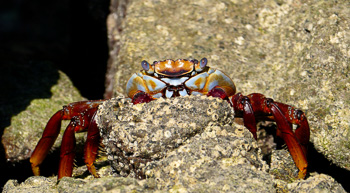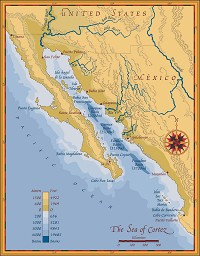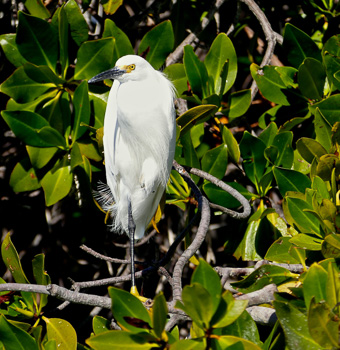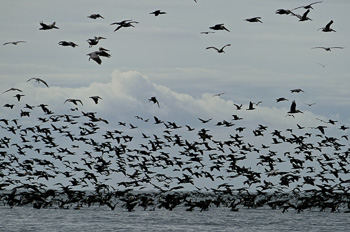-CRN_2016_brochure.jpg)
Blue-footed boobies (MH)
CONSERVATION IN FOCUS (1):
A VOYAGE TO BAJA CALIFORNIA AND
THE
SEA OF CORTEZ IN THE SPIRIT OF
ED RICKETTS AND JOHN STEINBECK
February 17-29, 2016
13 Days/12 Nights
Audrey Benedict, Dr. Geoff Hammerson,
Wendy Shattil & Bob Rozinski, Carlos Gajon
Bermúdez & the M/V Westward’s Crew
Standing on the Westward’s foredeck, we see a
cloudless arc of sky and a jagged spine of cactus clad
mountains towering above turquoise-hued
water. Rising mirage-like out of the Pacific
Ocean, Mexico’s Baja California Peninsula
stretches south as a slender 800-mile-long cul-de-
sac of the Sonoran Desert. A.jpg) long its austere
eastern shoreline, the Sea of Cortez (Gulf of
California) separates the Baja peninsula from the
rest of mainland Mexico. From Baja’s western
coast, the Pacific Ocean stretches across one-third
of the globe’s circumference before reaching the
shores of another continent. long its austere
eastern shoreline, the Sea of Cortez (Gulf of
California) separates the Baja peninsula from the
rest of mainland Mexico. From Baja’s western
coast, the Pacific Ocean stretches across one-third
of the globe’s circumference before reaching the
shores of another continent.
The sense that Baja California seems a world
apart reflects its remarkable plate tectonic history
and its biological setting. Baja California sits atop
the oceanic Pacific Plate while mainland Mexico
is situated on the continental North American
Plate. Deep-seated plate movements along the
southern trajectory of the great San Andreas Fault
caused the peninsula to begin rifting northwest
in relation to mainland Mexico about 25 million
years ago.
-CRN_2016_brochure.jpg)
Gray whale (MH)
By 5 million years ago, the Pacific
Ocean had flowed into the gulf-like breach
between the plates, ultimately creating the Sea
of Cortez. Episodes of intense volcanism along
the peninsula’s mountainous spine and the resulting
uplift of its eastern flanks produced the
spectacular scenery we see today and triggered
the region’s climatic transformation.
Tethered to the North American mainland by
a narrow land bridge and surrounded by Pacific
waters on three sides, Baja California is a treasure
trove of biodiversity. With the evolutionary stage
set by a million years of virtual isolation, the Sea
of Cortez’s 44 major islands and 900 smaller
islands host the largest number of endemic plant
and animal species in North America. Of the 695
species of island-dwelling vascular plants, 20
genera are endemic. These islands are also among
the world’s richest in terms of reptile diversity,
with at least  50 endemic species. 50 endemic species.
The late Jacques Cousteau, ocean explorer and
renowned conservationist, described the Sea of
Cortez as “the aquarium of the world.” Of the 891
species of fish that occur in these waters, 90 are
endemics. The region also contains 39% of the
world’s total number of marine mammal species
and one-third of the world’s cetacean species. In
fact, many biologists refer to the Sea of Cortez
and its islands as the “Mexican Galapagos.” In
2005, with tourism pressures, overfishing, and
other environmental threats taking a drastic toll,
UNESCO and the Mexican government designated
much of the Sea of Cortez and nearly 50%
of Baja California Sur as a World Heritage Site.
.jpg) Legendary marine biologist Ed Ricketts is known
for his pioneering studies of marine ecology along
the Pacific coastline of North America. His book
Between Pacific Tides, first published in 1939
and now in its fifth edition, remains the classic
reference for the Pacific intertidal zone for
students and scientists alike. In the spring of
1940, Ed Ricketts and his ocean-loving friend,
novelist John Steinbeck, embarked on a 4,000-
mile expedition aboard the Western Flyer, a
sturdy 76-foot purse seiner. The voyage would
take them from California’s Monterey Bay south
around Baja California to the Sea of Cortez. Both
men shared a profound curiosity and passion for understanding the marine world. They also
believed that their 6-week collecting trip in the
Sea of Cortez would open a window as wide and
horizonless as Charles Darwin had aboard the
Beagle. Their expedition resulted in two books—
Sea of Cortez: A Leisurely Journal of Travel
and Research (1941), which included Ricketts’
collection catalog, and The Log from the Sea
of Cortez (1951), the shorter version Legendary marine biologist Ed Ricketts is known
for his pioneering studies of marine ecology along
the Pacific coastline of North America. His book
Between Pacific Tides, first published in 1939
and now in its fifth edition, remains the classic
reference for the Pacific intertidal zone for
students and scientists alike. In the spring of
1940, Ed Ricketts and his ocean-loving friend,
novelist John Steinbeck, embarked on a 4,000-
mile expedition aboard the Western Flyer, a
sturdy 76-foot purse seiner. The voyage would
take them from California’s Monterey Bay south
around Baja California to the Sea of Cortez. Both
men shared a profound curiosity and passion for understanding the marine world. They also
believed that their 6-week collecting trip in the
Sea of Cortez would open a window as wide and
horizonless as Charles Darwin had aboard the
Beagle. Their expedition resulted in two books—
Sea of Cortez: A Leisurely Journal of Travel
and Research (1941), which included Ricketts’
collection catalog, and The Log from the Sea
of Cortez (1951), the shorter version  Steinbeck
published following Ricketts’ tragic death in
1948. Steinbeck often described their expedition
as “bright with sun and wet with sea water.”
We follow in their wake ... Steinbeck
published following Ricketts’ tragic death in
1948. Steinbeck often described their expedition
as “bright with sun and wet with sea water.”
We follow in their wake ...
Our expedition to Baja California begins in
Loreto, a picturesque town located on Baja’s
eastern shore. We’ll travel by van along this
beautiful coastline and then across the peninsula’s
jagged spine to Laguna San Ignacio, one of the
three lagoons on Baja’s west coast where gray
whales gather in large numbers to give birth and
breed. From our safari-style tented camp, our
guides will take us in small open pangas to spend
an unforgettable morning and afternoon drifting
quietly in the lagoon in the midst of gray whale
mothers and their calves. The experience is truly
magical because the whales seem to be as curious
about us as we are of them and may bring their
calves right up to the boats.  Imagine what it will
be like to fall asleep listening to the breath sounds
of hundreds of sleeping whales echoing across the
star-lit water. Imagine what it will
be like to fall asleep listening to the breath sounds
of hundreds of sleeping whales echoing across the
star-lit water.
With memories of gray whales tucked away
in our hearts and minds, we return to Loreto
and begin our voyage in the Sea of Cortez.
Westward’s naturalist, kayak and snorkeling
guide is Carlos Gajon, a La Paz native, whose
knowledge of the region’s human history and its
remarkable ecosystems is legendary! He joins our
naturalist team at the helm for this spectacular
adventure. After being welcomed aboard by Capt.
Bill Bailey and the Westward’s crew we’ll get
underway for Isla Danzante. From the bow, we’ll
watch for red-billed tropicbirds and elegant terns
swooping over the water and brown pelicans
fishing the shallows. Traveling south, with The
Log from the Sea of Cortez in hand, we’ll visit
several of the island and peninsula collection sites
made famous by the pioneering Ricketts-
.jpg) Steinbeck expedition 75 years ago. On trips
ashore, we’ll explore the Sonoran desert world
and search for some of the endemic plant and
animal species that inhabit these islands. On some islands, giant cardón cacti tower over a prickly
understory of shrubs, providing welcome shade
for a giant chuckwalla or a delicate gecko.
Desert birding should treat us to good looks at
pyrrhuloxia, white-winged doves, Gila woodpeckers,
or the endemic Xantu’s hummingbird. Steinbeck expedition 75 years ago. On trips
ashore, we’ll explore the Sonoran desert world
and search for some of the endemic plant and
animal species that inhabit these islands. On some islands, giant cardón cacti tower over a prickly
understory of shrubs, providing welcome shade
for a giant chuckwalla or a delicate gecko.
Desert birding should treat us to good looks at
pyrrhuloxia, white-winged doves, Gila woodpeckers,
or the endemic Xantu’s hummingbird.
Back aboard, drifting quietly through the nutrientrich
waters of the blue triangle, we’ll hope to spot
blue and sperm whales as they congregate to feed
on the bounty of plankton and squid. We’ll learn
how El Niño and La Niña cycles in the Pacific
influence the abundance of marine life and drive
the storm systems that deliver nurturing moisture
to the Baja peninsula and to the islands. Continuing
south toward Isla San Jose, we’ll have all eyes
watching for black and least storm petrels skimming
over the waves, foraging pairs of Craveri’s
murrelet, the tiniest of all murrelets, both bluefooted
and brown boobies, Heermann’s gulls, and
magnificent frigatebirds.  It is not uncommon to
be treated to the aerial displays of mobula rays or,
if we are lucky, the arrival of hundreds of longbeaked
common dolphins riding our bow. We’ll
use sea kayaks to explore the labyrinth of mangroves
in San Jose’s expansive lagoon, everwatchful
for yellow-crowned night herons, white
ibis, and mangrove warblers. It is not uncommon to
be treated to the aerial displays of mobula rays or,
if we are lucky, the arrival of hundreds of longbeaked
common dolphins riding our bow. We’ll
use sea kayaks to explore the labyrinth of mangroves
in San Jose’s expansive lagoon, everwatchful
for yellow-crowned night herons, white
ibis, and mangrove warblers.
From our anchorage offshore IslaSan Francisco,
we’ll get an early start and cruise past the California
sea lion haulout at Los Islotes and then head
to Isla Partida and Caleta Cardonal. We’ll wander
the island’s mangrove-fringed shore and then hike
to its beautiful desert heart. Our voyage’s final
anchorage will be at Bahia San Gabriel, along Isla
Espiritu Santo’s west side, where a spectacular
colony of frigatebirds awaits us..jpg) The crystalline
waters of our final night’s anchorage mayinvite
a sea kayak trip, a snorkel, or a sunset beach walk.
Back aboard the Westward, we’ll celebrate and
savor thehighlights of our trip over a fabulous
dinner, raising our glasses to a final Baja sunset
and the gift of our friends and crew. The crystalline
waters of our final night’s anchorage mayinvite
a sea kayak trip, a snorkel, or a sunset beach walk.
Back aboard the Westward, we’ll celebrate and
savor thehighlights of our trip over a fabulous
dinner, raising our glasses to a final Baja sunset
and the gift of our friends and crew.
Price: $6,950 (includes a $1,000 deposit)
Group Size: 12 Trip Rating: 2-3
 Price includes:3 nights’ hotel accommodations
(including 2/17 at a hotel near theLA airport and
2/18 & 2/20 in Loreto), 1 night (2/19) in the
safari-style tented camp at San Ignacio Lagoon,
all van transportation ashore, all meals ashore,
8 nights aboard Westward, 5 naturalist leaders, Westward’s 4-person crew,sea kayak outfitting
and instruction, gratuities throughout, and a
copy of the photo book of our voyage. Price includes:3 nights’ hotel accommodations
(including 2/17 at a hotel near theLA airport and
2/18 & 2/20 in Loreto), 1 night (2/19) in the
safari-style tented camp at San Ignacio Lagoon,
all van transportation ashore, all meals ashore,
8 nights aboard Westward, 5 naturalist leaders, Westward’s 4-person crew,sea kayak outfitting
and instruction, gratuities throughout, and a
copy of the photo book of our voyage.
The price
quoted is per person based on double occupancy.
Single accommodations are unavailable for this
trip.
Does not include roundtrip airfare from your
departure point to Loreto or your return home
from Los Cabos.
|
.jpg)